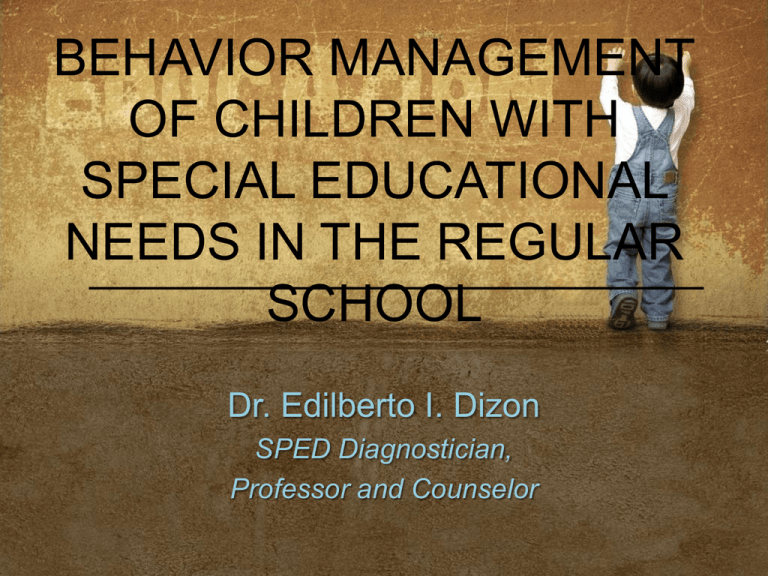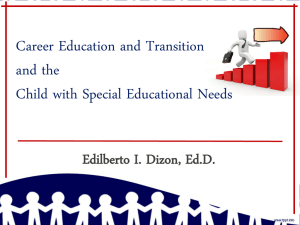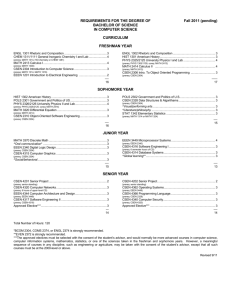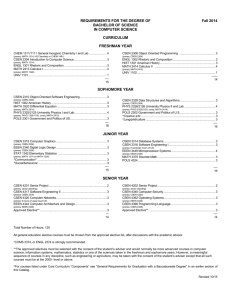BEHAVIOR MANAGEMENT
advertisement

BEHAVIOR MANAGEMENT OF CHILDREN WITH SPECIAL EDUCATIONAL NEEDS IN THE REGULAR ________________________ SCHOOL Dr. Edilberto I. Dizon SPED Diagnostician, Professor and Counselor Behavior Management The inclusion of children with special educational needs (CSEN) in the regular school poses a challenge to all stakeholders. Their inclusion does not only fulfill the goals of normalization but also enables concerned parents, teachers, administrators and other support persons to collaborate and plan systematically a doable, purposive and supportive program for a CSEN. Behavior Management The main reason for inclusion is for the CSEN to achieve the ceiling level of psychosocial development and achievement. Behavior Management Progress in all other areas of development is possible only after the child has achieved a level of behavioral manageability and maturity. That is what makes behavior management the centerpiece of intervention. Behavior Management Developmental priorities are much easier to address only if the child is able to sit, attend, focus, comply, perform and finish what he performs. Behavior Management What are the essential considerations and guidelines in readying the child behaviorally and socially, and thereafter, pursuing higher goals of psychosocial maturation? Behavior Management 1. Background and Current Developmental Levels of the Child --> The psychoeducational evaluation provides a comprehensive background and current levels of the child which serve as the baseline entry data for instructional designing and programming. Behavior Management 2. Inclusion and Behavior Management --> The child is given the needed opportunities to socialize and learn with his regular peers so that in the end, he will behave and socialize much more appropriately not only in school but also in other places. Behavior Management 3. Adaptation --> We teach a CSEN to adapt to his physical environment through socialization and appropriate behavior management. The school constituents especially his classmates, serve as potent role models and guides to enable the child to achieve the goals of inclusive education. Behavior Management 4. Identification of Priority Targets for the Child --> School support persons must specify and follow through the shaping/ extinction/ modification of identified priority behaviors, which may include: self-concept, self-confidence, self-regulation, sense of responsibility, independence training, decision-making, sense of otherness/empathy, and other specific behavioral concerns (e.g., anger management, frustration tolerance, impulse control, verbal-social propriety). Behavior Management 5. Unfolding and Transformation Given a supportive and conducive physical, and social-emotional context, the child will be receptive to programs and Services designed for him. Behavior Management 6. Collaboration -->Working closely with other stakeholders including ancillary and auxiliary service-givers remains extremely helpful to achieving set objectives. Behavior Management 7. Utilizing Co-/Extra-Curricular Activities --> These enable the child to engage in his fields of interest alongside other children. Such activities serve as avenues for talent-/skill-building, socialization, cooperation, team-building verbal reciprocity, creativity, etc. Behavior Management 8. Modification of Environment --> “The child becomes where and with whom he is placed.” The environment, therefore, can be structured to address specific behavior concerns. Behavior Management 9. Utilizing Behavior-management Strategies --> Every teacher must use appropriate behavior-management strategies to address specific behavior-social concerns. Behavior Management end INSTRUCTIONAL MANAGEMENT OF CHILDREN WITH SPECIAL EDUCATIONAL NEEDS IN THE REGULAR ________________________ SCHOOL Dr. Edilberto I. Dizon SPED Diagnostician, Professor and Counselor Instructional Management Attending an inclusive school generates doubts whether the CSEN can meet regular-class standards. But inclusive education does not, in the first place, compete and compare the child to meet regular-class standards! Instructional Management We need, therefore, to clarify and explain further how it is to educate the CSEN in the regular school. This is a difficult task to do knowing too well that the child is placed in a class based on his age not on any other criteria, i.e., ability level, disability, physical built and behavioral attributes. Instructional Management What must be done, therefore, to make learning of the CSEN truly meaningful, relevant, functional and inspiring? Instructional Management 1. Prescriptive Teaching --> Designing an instructional program for a CSEN largely relies on the results of a thorough psychoeducational assessment. Instructional Management 2. Individualization Individualize intervention by sequencing skills developmentally following the specified criteria of priorities in the different developmental areas. Instructional Management 3. Realistic Expectations Set realistic expectations by targeting functional and relevant priorities based on the assessment data. Instructional Management 4. Appropriate Teaching Methodologies Utilize appropriate teaching strategies/methods considering the assessment results as well as the child’s learning styles, difficulties and also his rate and pace of learning. Instructional Management 5. Generalization Provide plenty of remediation, drills and application in practical situations for mastery learning. Instructional Management 6. Schedule of Implementation Continue providing a specific time allotment/schedule for implementing the individualized program during your and the child’s free time other than during the lessons in the classroom. Instructional Management 7. Instructional Materials Use needed instructional materials with provision of several variants which can be used in varied learning situations. Instructional Management 8. Home and Community Resources . Utilize home and community events, experiences, resources/materials, etc. consistent with/related to school lessons. Involve also home and community resource persons like parents and community helpers in making lessons interesting and practical. Instructional Management 9. Mastery Learning Modify, simplify and program lessons to facilitate and ensure Mastery learning. Instructional Management 10. Linkages Work closely with other auxiliary and ancillary support specialists for specific concerns and also for follow-up of the child’s progress. Instructional Management 11. Evaluation Utilize multi-sources in determining the child’s achievements/progress and also for rating the child (interviews, observations, peer ratings, child’s portfolios). Do not rely solely on test results to gauge achievement/ progress. Instructional Management 12. Documentation Use checklists, journals, diaries, etc. to record, monitor and follow up the child’s progress. It is best to see how the child progresses daily/weekly within a time span/duration. Such documentation of gains/achievement is also helpful in succeeding instructional programming. Instructional Management 13. Peer Involvement Involve the child’s peers in providing needed verbal and social stimulations as well as serving as helpful role models. Instructional Management 14. Compensatory Education Harness the child’s potential for specific talents/skills/abilities by providing plenty of opportunities for actual-skills/talent/ability demonstration/participation. These are also meant to offset the child’s limitations. Instructional Management Thank you!








